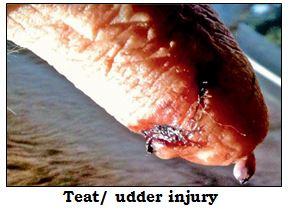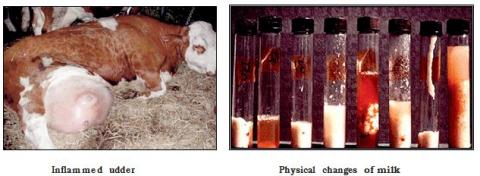
- It is one of the 3 forms of contagious udder infections where physical changes are clearly visible in udder and milk. High yielding animals are more prone. Mainly caused by bacteria (around 100 types). Also caused by fungi, virus & rarely by algae.
MAJOR PRE-DISPOSING FACTORS
- Unclean animal/shed
- Faulty milking practices
- Udder Injury
MAJOR SYMPTOMS
- Inflammed udder in clinical mastitis
- Physical changes of milk in clinical mastitis
PREVENTION
- Manage the pre-disposing factors of mastitis properly.
- Before milking, clean the udder well with clean water and wipe dry with clean towel. Should use separate cloth towel for each animal. Disposable paper towel is also an option. Repeated use of unclean towel may itself predispose to mastitis.
- Milking should be quick, complete and hygienic.
- Milk animals with chronic mastitis in the end. (see chapter on this)
- Carry out teat dipping or spray immediately after milking.
- Prevent the animal from sitting for at least 30-45 minutes after milking.
- Periodically check and treat for sub-clinical mastitis (see chapter on this).
- Keep the floor of the cattle shed without holes and as dry as possible.
- Continue teat dipping/spray 2 weeks after drying off and start the practice two weeks before calving.
- Carry out proper fly control.TREATMENT
TREATMENT
- Contact a veterinarian immediately. Early treatment (within 2-3 hours) improves the chances of cure, delayed treatment may cause loss of udder or even death of animal.
- Milk of animal suffering from mastitis should be discarded at least for 4 days after the treatment is over or as directed by the veterinarian.
Detect and treat cases early. Avoid loss of udder or animal.

